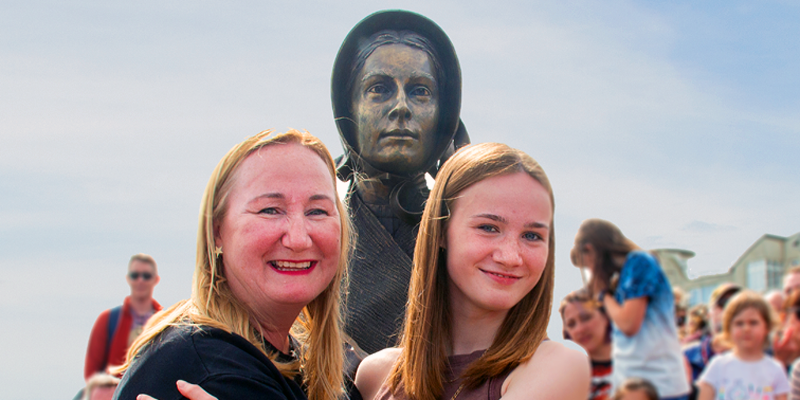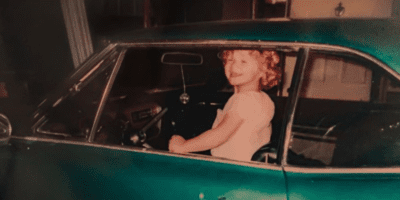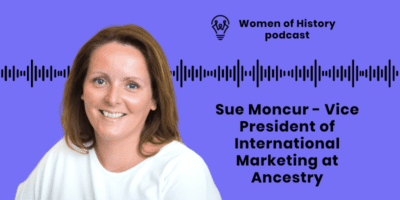Anya Pearson is a fashion professional with no background in science, palaeontology or geology, but when her young daughter, Evie, asked her why there was no statue for Mary Anning, an incredible palaeontology pioneer, she decided to made it her mission to right that wrong. Together, Anya and Evie set about galvanising wide ranging support from experts, public figures and the wider community around the world. Through their work on the Mary Anning Rocks charity, the mother and daughter pair and their supporters have successfully raised more than £150k to date, and the campaign they lead has funded a life-sized statue of Mary Anning that now proudly stands on Lyme Regis beach, having been unveiled on what would have been Mary’s 223rd birthday in May 2022.
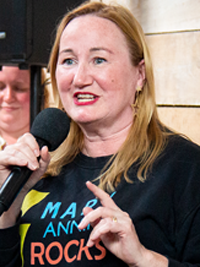
“Until recently it’s all been about ‘behind every good man…’ and all that bullshit. The amazing women involved in the history of geology and palaeontology were written out because it was all written by men for men.”
Discovering Mary
I’m from the north of England, a born and bred Mancunian. My background is that I have BA (Honours) degree in Fashion Design Marketing. I graduated in 1990, and I’ve worked in fashion all my life. Currently, I’m a lecturer at the Arts University of Bournemouth and The Winchester School of Art, teaching fashion.
I also have my own professional practice where I work with a number of fashion brands as a freelancer, and a bit of a trouble-shooter. So, after 35 years in the industry, I can just parachute in now and sort out problems, help people build brands and sort out their manufacturing issues.
We lived in London for a long, long time before we moved to Dorset about 18 years ago. In 2005 I was in a local book club and somebody put forward a historical novel. They’re not really my kind of cup of tea, but being in a good book club means that you get to read things that you wouldn’t necessarily choose yourself. It was the Tracy Chevalier book, Remarkable Creatures, which was about Mary Anning, an absolutely amazing scientist (a palaeontologist), who was around at the birth of geology and palaeontology, and Elizabeth Philpott, who was really helpful in Mary’s early career.
Elizabeth helped Mary a lot with her reading, writing and research. Elizabeth, who you don’t really hear a lot about either, was an amazing fossil fish expert and they had an incredible collection of fossils. I read this book and just couldn’t believe that this amazing woman had been living 20 minutes down the road and I’d never ever, ever heard of her. She’d never once been part of any of the conversations around the Jurassic Coast or fossil hunting.
A woman in a man’s world who refused to let anything stand in her way
What was so incredible about Mary was not only was she a woman in a man’s world, which is enough to set her apart from everybody else, but the fact that she did it all from a baseline of poverty. She was this uneducated woman in a man’s world. She was the three things you wouldn’t want to be in Victorian Britain — she was poor, she was working class and she was a woman.
But with all of this on her shoulders, she just didn’t let anything stand in her way. She was one of the first people to recognise that these fossilised remains that she was digging up along the Jurassic Coast in Dorset were the long-dead remains of animals.
I’m not a religious person, but what you’ve got to remember as well, which was equally as mind-blowing was that at this time, the Bible was telling everyone that the world was 8,000 years old, but it was clear to Mary that these things had lived millions and millions of years ago to have been turned into stone.
She was a dissenter, so obviously as a lot of people back then were very religious you can imagine that this turmoil that was being unearthed literally and metaphorically speaking was quite a turning point and she was at the kind of the cusp of lots of revelations.
Despite the fact that she was such an exciting pioneer and such a brilliant role model, she was completely forgotten. She wasn’t in any of the major textbooks.
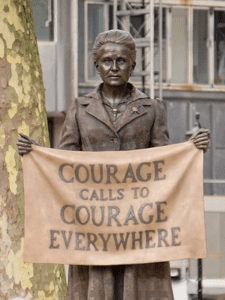
So, the project was born from an accumulation of all of these different things, although the actual firework was lit and set off when my daughter, Evie, was ten years old. It was the anniversary of a hundred years of suffrage, and her brilliant teacher had taught her class all about suffragette movement, and she’d shown them the picture of the only statue of a woman in Parliament Square in London, of Millicent Fawcett.
Evie got quite buzzed about that and when we were coming off the beach at Lyme Regis one day after some fossil hunting, she very innocently asked to go and see Mary’s statue. I had that really horrible conversation that mothers have with their daughters where they explain to them that women in Victorian times were considered as property. I had to tell her that they were owned by their fathers and then owned by their husbands when they got married. They couldn’t earn their own money, have their own bank accounts and were pretty much treated like belongings.
It was Evie’s physical reaction to that which really hit home to me. Her neck went really red and she was very, very angry. And through gritted teeth she said: “Why is it, Mummy, that, after all these years, women can’t just be brilliant?” And I thought: “Oh my God. From the mouths of babes…” It was just such a really poignant, lovely, innocent, gorgeous thing to say that I just couldn’t let it go.
So that day on the beach was when Mary Anning Rocks was born. That was five years ago and Evie’s 15 now.
How to Build Statues for Dummies
We were initially really naïve. I wish there was a book called How Build Statues for Dummies, because obviously I’d have gone into Waterstones and bought that, but there wasn’t. So, we went into it quite naïvely and just thought that we would reach out to the three Lyme Regis organisations that would have attachments to either fossiling or Mary herself, just to see if they thought it was a good idea, if they wanted to join if they could give us any advice or support.
We were pretty much ignored by all three organisations, and that didn’t go down very well with me when I’m ignored. I thought: “Well, people are just busy.” And I sent emails again.
Then by the third email I did get a reply from one group and they advised me to speak to one of the other groups I was already talking to. In the end it all boiled down to this one particular organisation. I’m not going to name names, what’s the point, but they know who they are.
So, I was just ignored and ignored and ignored, and so I thought: “I’m gonna get this person on the phone.” I managed to get through to this bloke and he knew exactly who I was. He’d obviously read every single email I had sent him. He proceeded to mansplain for 10 minutes down the phone to me, which just left me speechless, which as you can imagine from talking to me, is something that doesn’t happen very often.
Going it alone
So, I put the phone down and I thought: “Well, that answers my question. We’re going to have to do this on our own,” because I can’t work with people who are basically rude and, and uncooperative, and have their own agendas. It was just very, very odd.
So, we just started our own committee. We began with social media. We named it, we branded it. I work with fashion marketing and branding, that’s what I do, so I thought: “I’m going to use all my skills I know I’m good at and apply them to the campaign.” And it was a really smart move, because once you name something, it comes alive. People can get behind that banner. We did that quite quickly with my graphic designer friend. and now trustee. Esther Yarnold. and as soon as you start a social media campaign, you start to build your crowd, and it snowballed from there.
We held a committee meeting to start with, and one of the people who came along to that was a geologist that had worked at the organisation where the man had been so unhelpful. She said that following that telephone conversation they were all called into a room and told by this man that anyone who worked there was “not to get involved with that woman and her kid” because what did they think they could do?
That was it for me. That was like a red rag to a bull. From that moment, I thought: “Right, I’ll show you exactly what this kid and that woman can do.”. And that’s when Mary Anning Rocks was born.
We had about a year’s delay because we were messed about by members of the town council. We were very badly advised by a group of councillors who were just time wasters. Even Jackie Weaver would’ve struggled. There was an AGM, which was awful, but we finally voted them all off.
Reaching out for support
The first thing that we did was we decided to register as a charity. We got some really brilliant people on board quite quickly. We knew that David Attenborough was a huge fossil fan and that we’d heard him talk about Mary Anning quite a few times. And of course with the Attenborough Sea Dragon, the ichthyosaur whose 200-million-year-old fossil that was found on the Jurassic Coast, which is now in the Charmouth Heritage Coast Centre we thought, well, it was a no-brainer to ask for his support.
I said to Evie: “We need to get some patrons.” And she said: “What’s a patron, Mummy?” And I said, “Oh, they’re like really, really important people who have got a lot of sway that can be our allies.” I said, “Who is the most important famous person you can think of?”
And she sat there really thinking, and I could see her brain turning over. And then a little light bulb went on over her head and she said: “Sir David Attenborough. Let’s get David Attenborough,” as if it was as easy as going down the shops to buy a bag of carrots.
So, I had to explain to her that he’s a really busy man and he is probably asked a thousand times a minute to help people, so I said: “Be prepared that he might say no. Don’t be too upset darling if he says no.” So, she said: “I’m going to write him a letter and I’m going to paint him a painting of how I think the statue should look.” And she wrote this beautiful little handwritten letter asking him if he thought it was a good idea and would he like to become one of our supporters.
Then she stuck one of her little ammonites [fossils] in the corner of it and off it went. Sir David doesn’t do email. So, off this letter went and I said: “Don’t get too excited. You probably won’t even hear anything back.”
What a wonderful idea
Within two days she received a handwritten letter back from David, saying: “What a wonderful idea,” and that he totally supported it. He said: “Add me to your list. Love the painting, and your ammonite is now the smallest in my collection. Thank you very much.” And that was it. That’s how he came on board.
Evie has kept him up to date. He did write a letter quite early on saying that with the time he’s got left on planet Earth, he really wants to concentrate on saving it. But as an advocate, he’s been brilliant. He’s allowed us to use his voice in certain ways, but he’s very focused on saving the planet at the moment.
And then we reached out to Professor Alice Roberts because I personally just love Alice and she’s a massive advocate for women in science. And she said: “Totally. Definitely sign me up.” She has been a very active member of our patrons. She pretty much did the crowdfunding campaign film for us, which was filmed at the Natural History Museum with her. She gave her time to do that, which was brilliant.
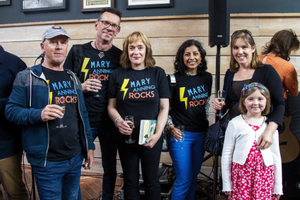
We also got Dr Anjana Khatwa, Dr Dean Lomax and Dr Tori Herridge onboard too — all really interesting people in the field of geology and palaeontology supporting us and following us. We’ve also got Tracey Chevalier who wrote the book I’d first read about Mary. There’s also several organisations who’ve supported us too.
Happy 223rd birthday, Mary Anning
I reached out to other campaigns to ask their advice, but they were all campaigns that had gone on in quite large cities. The kind of demographic and the types of councillors that you deal with in bigger cities are a little bit more on par because they can’t get away with kind of tin pot politics.
I think it’s slightly easier to raise statues in Manchester or London, but it quickly became very clear talking to a couple of other people who had worked on projects in market towns, like the Elizabeth Emily statue that went up in Congleton, that in small market towns it is really difficult to get everyone on side when it comes to planning and so on.
We were rattled by the year we had had with these awful town councillors on our committee, so we decided that we would connect and work with the children within the community. During lockdown we got a local artist, Darrell Wakelam, to put together a project for the school children to do where they could help design their own Mary statue.
The sculptor we picked, Denise Dutton, who is a genius, and an absolutely incredible artist, then picked a winner and runner-up from each school, and then the elements of those designs were used within her final sculpture. So, there was this kind of connectivity with the kids who are ultimately going to be her caretakers far longer than any of us on the committee so it made complete sense to involve them.
It also made sure that the community was involved. There was a real importance for that. I didn’t want us to just create something the community had no say in as it was to sit in their backyard. I’d have been a bit annoyed by that so I wanted to have the community input and it worked really well.
A lot of the details on the statue came about from this: Incorporating the ammonites on her skirt; the actual layout of her striding down to the beach; and the fact that every single drawing had Tray the dog in it. She was also walking over all her finds, so on the platform that she’s walking on there’s a plesiosaur paddle and an ichthyosaur skull and ammonites.
The whole thing was beautifully done by Denise Dutton. It was just such a wonderful, exciting process. It started from the maquette stage. The maquette is a 12-inch scaled-down version that artists do first to get sign off. The maquette itself is beautiful and it’s actually on a year-long tour around Britain going from museum to museum at the moment. I think it’s currently at the Welsh National Museum Cardiff and then it’s off to the Leeds City Museum.
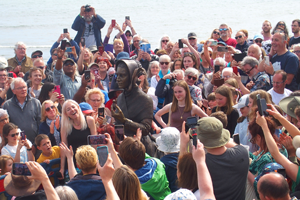
The beautiful bronze of the statue was unveiled on Mary’s 223rd birthday, last May she was unveiled to 2000 people by the schoolchildren, Evie and Professor Alice Roberts. It was an absolutely amazing day.
Galvanising support
We needed to raise £70,000 for the statues — the bronze, and for the artist to physically make the statue. We also had to factor in the costs for all the legals, planning, logistics and the plinth making, as well as shipping it down from the foundry in Wales, as well as a £15k contingency fund in case anything went wrong.
We decided we’d have to go for £100k at least to really do this. We literally smashed the £100k and then we went through £125k. With the gift aid on top of that, we reached £150k. There are people on our committee who have been there from day dot, really lovely people.
This week I had a group reach out to me from Hinckley in Leicestershire. They want to raise a statue for Ada Lovelace because she spent time there in her childhood, and so they were asking what would be my top tips. The biggest top tip I gave them is to have a small committee of like-minded people that you trust, who can take directions and who don’t have ulterior motives.
There’s another group in Scotland who have been campaigning for a statue to commemorate the first female doctor in Scotland, Elsie Inglis. She was also an LGBTQ+ pioneer. Their campaign is brilliant.
We’ve also got a spinoff group, called VISIBLEWomen, because we have so many people reaching out to us, asking us: “How did you do it?” We now have a female-led female group on WhatsApp.
Mary’s legacy
What I see as a result of the campaign, which is so heartening, is the amount of young girls who just absolutely love May Anning’s story, and they’re obsessed with dinosaurs, geology and fossils. We get two or three direct messages or posts on Facebook with photographs of them with their finds.
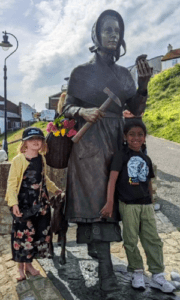
Especially this week too because it’s World Book Day, we get inundated with little girls and boys dressing up as Mary and sending in their pictures. It’s just absolutely amazing that she is so much in their consciousness. They’re growing up with her name ringing in their ears so we definitely don’t need to worry about Mary ever being forgotten again.
Also, I think about five or six years ago, the mention of Mary Anning was added to Key Stage One (KS1) of the school curriculum in relation to rocks and geology. What I really like as a result of that is now in the summer the beach at Lyme Regis is full of people and you see young kids, especially little girls, who have learned about her at school, dragging their parents down to the South Coast.
Writing women back into the history books
I always reflect when people ask me: “What’s the point of statues and why should that be important?” It’s this almost subliminal message that we send, especially to our children. Women are kind of invisible, even though they were part of how we have developed and grown as the human race.
The fact that they’re not mentioned in history books is just plain wrong. Until recently it’s all been about ‘behind every good man…’ and all that bullshit. The amazing women involved in the history of geology and paleontology were written out because it was all written by men for men.
How the Womanthology community can get involved
Because we raised so much money with the crowdfunding campaign, we’ve got about £55k left in the kitty. As a registered charity, we decided with our trustees quite a long time ago that we would have an ongoing project that would be called the Mary Anning Rocks Learning Legacy. At the moment we’re working with educationalists to produce downloadable packs for schools that register with us. They will be regularly updated too.
We’re revamping the website as well to make that more interactive for schools and children, but it’s also for anybody interested in Mary and they too can join our mailing list and get one too. There’ll be lots of free downloadable stuff as well on the website.
More importantly though, what we want to try and do is to fund trips so children from underserved backgrounds who wouldn’t usually even get a chance to go to the beach, let alone go hunting fossils and find a million-year-old-creatures for themselves. Out of a group of 20 kids that we do that for, from one school, even if we only inspire one child, that’s enough for me.
We’re trying to encourage them that if Mary can break down all those barriers, with all those things that were thrown in her way, even though she was constantly told, “no, you can’t do that”, they can do it too.
I’d encourage the Womanthology community to follow us on social media. We’ve got an email list as well, so you can sign up on the current website. (As I said, we’re in the process of revamping the website, and the new one will hopefully launch in the summer, but we’re still out there in the meantime.)
The crowdfunding page is still open, so if people want to donate, they can definitely do that still. We have merchandise as well, which has been a really brilliant way to raise funds. We teamed up with Tee Mill and we’ve got some absolutely brilliant designs on there, including some tongue-in-cheek ones, which are really funny. People can buy t-shirts and posters, stickers and things too.
Follows us on social media at @MaryAnningRocks we are on Facebook, Twitter and Instagram
Exciting times
We’ve just run a family science day at Dorchester Museum. We’re meeting a garden designer for a famous gardening event in London so it would be really incredible if that came off. Evie and I were also awarded a Points of Light Award by the Prime Minister last year and I was made a Woman of the Year 2022, which was very unexpected.
Evie and I were also asked to write a book about our journey in parallel with Mary’s story. We’ve got a literary agent and the book proposal is out. There’s a lot of stuff out there that’s written about her personal life that’s mainly guesswork. She’s pretty much painted as this monosyllabic, miserable, dowdy woman and a lot of people take that as gospel. We see her as very engaged and eloquent. She was this working-class, self-educated woman who was invited into the homes of upper and middle-class Victorian society, so we have made it the next part of our mission to set the record straight.

